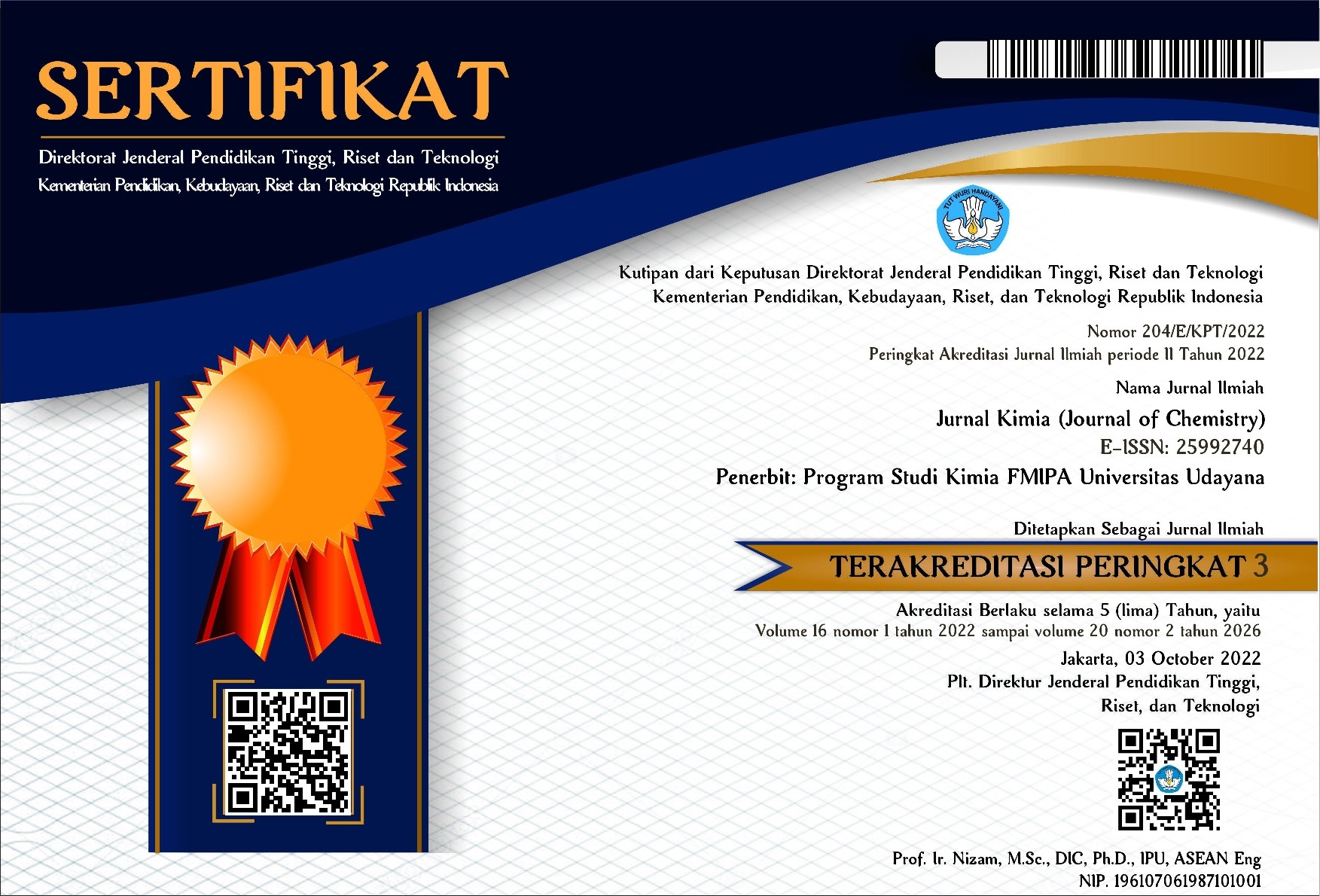STUDI INTERAKSI GLYCOGEN SYNTHASE KINASE-3? DENGAN SENYAWA AKTIF HIBISCUS SABDARIFFA LINN. SECARA IN SILICO
Abstract
Hibiscus sabdariffa Linn. (HSL) merupakan salah satu tanaman yang ada di Indonesia. Tanaman tersebut diketehui mengandung banyak senyawa aktif yang berkhasiat, seperti quercetin. Senyawa tersebut termasuk dalam golongan flavonoid yang diketahui berpotensi untuk menghambat aktifitas Glycogen Synthase Kinase-3? (GSK-3?). GSK-3? terlibat dalam berbagai aspek fungsi otak mulai dari perkembangan otak awal, hingga berbagai aspek fungsinya pada orang dewasa seperti perkembangan sinaptik yang tepat dan transmisi saraf. Disregulasi aktivitas GSK-3? baik pada perkembangan awal atau pada masa dewasa dapat menjadi predisposisi gangguan neuropsikiatri dan neurologis. Penelitian ini bertujuan untuk mengidentifikasi, mengevaluasi serta mengeksplorasi afinitas dan interaksi molekuler antara senyawa aktif HBS terhadap GSK-3? dengan menggunakan simulasi penambatan molekuler secara in silico. Penelitian ini diawali dengan preparasi GSK-3? dan penetapan sisi aktifnya menggunakan ligan alaminya. Selanjutnya dilakukan studi interaksi molekuler antara senyawa aktif HSL terhadap sisi aktif GSK-3? dengan metode molekuler docking. Hasil uji menunjukkan bahwa Methyl_ epigallocatechin dan 3-Methylquercetin memiliki kemampuan untuk berikatan dengan GSK-3?. Dari hasil molekuler docking dan farmokokinetik dapat disimpulkan bahwa senyawa Methyl_ epigallocatechin dan 3-Methylquercetin berpotensi menjadi inhibitor kompetitif GSK-3? berdasarkan studi in silico.
Kata kunci: GSK-3?, Diabetes Melitus, Hibiscus sabdariffa Linn.
ABSTRACT
Hibiscus sabdariffa Linn. (HSL) is one of the plants in Indonesia. These plants are known to contain many efficacious active compounds, such as quercetin. These compounds belong to the class of flavonoids which are known to have the potential to inhibit the activity of Glycogen Synthase Kinase-3? (GSK-3?). GSK-3? is involved in various aspects of brain function from early brain development, to various aspects of its function in adults such as proper synaptics and nerve transmission. Dysregulation of GSK-3? activity either in early development or in adulthood can predispose to neuropsychiatric and neurological disorders. This study aims to identify, evaluate and investigate the affinity and molecular interactions between HBS active compounds for GSK-3? using in silico molecular docking simulations. This study began with the preparation of GSK-3? and determination of its active site using natural ligands. Furthermore, a molecular interaction study was carried out between the HSL active compound and the active site of GSK-3? using the molecular docking method. The test results showed that Methyl_ epigallocatechin and 3-methylquercetin had the ability to bind to GSK-3?. From the results of molecular docking and pharmacokinetics, it can be concluded that the compounds Methyl-epigallocatechin and 3-Methylquercetin have the potential to become competitive inhibitors of GSK-3? based on in silico studies.
Keywords: GSK-3?, Diabetes Mellitus, Hibiscus sabdariffa Linn.
Downloads
References
Herranz-López, M., Olivares-Vicente, M., Encinar, J.A., Barrajón-Catalán, E., Segura-Carretero, A., Joven, J. and Abdullahi, M. and Adeniji, S. E., 2020. In-silico molecular docking and ADME/pharmacokinetic prediction studies of some novel carboxamide derivatives as anti-tubercular agents. Chemistry Africa. 3(4):989-1000.
Herranz-López, M., Olivares-Vicente, M., Encinar, J. A., Barrajón-Catalán, E., Segura-Carretero, A., Joven, J. and Micol, V., 2017. Multi-targeted molecular effects of Hibiscus sabdariffa polyphenols: an opportunity for a global approach to obesity. Nutrients. 9(8): 4
Jaworski, T., Banach-Kasper, E. and Gralec, K., 2019. GSK-3β at the intersection of neuronal plasticity and neurodegeneration. Neural plasticity. 2-9.
Lipinski, C. A., Lombardo, F., Dominy, B.W. and Feeney, P.J., 2012. Experimental and computational approaches to estimate solubility and permeability in drug discovery and development settings. Advanced drug delivery reviews. 64: 4-17.
Meng X-Y, Zhang H-X, Mezei M, Cui M.2011.Molecular Docking: A Powerful Approach for Structure-Based Drug Discovery. Curr Comput Aided-Drug Des [Internet]. 2011 Jun 1. 7(2):146–57. Available from: http://www.eurekaselect.com/openurl/content.phpgenre=article&issn=15734099&volume=7&issue=2&spage=146.
Spinelli, M., Fusco, S. and Grassi, C. 2019. Brain insulin resistance and hippocampal plasticity: mechanisms and biomarkers of cognitive decline. Frontiers in neuroscience. 13: 788.
Wang, Y. & Mandelkow, E. 2016. Tau in physiology and pathology. Nature reviews. Neuroscience. 17: 5–21.

This work is licensed under a Creative Commons Attribution 4.0 International License





